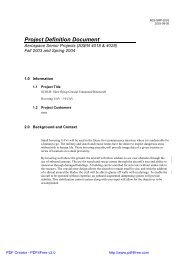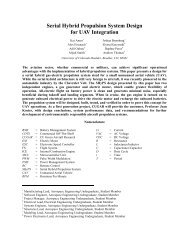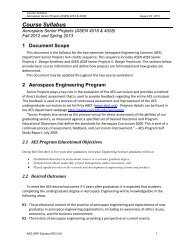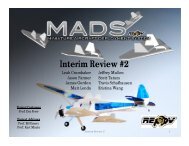PFR - Aerospace Engineering Sciences Senior Design Projects ...
PFR - Aerospace Engineering Sciences Senior Design Projects ...
PFR - Aerospace Engineering Sciences Senior Design Projects ...
Create successful ePaper yourself
Turn your PDF publications into a flip-book with our unique Google optimized e-Paper software.
Project Final Report – CUDBF April 30 th , 2009<br />
ASEN 4028: <strong>Aerospace</strong> <strong>Senior</strong> <strong>Projects</strong><br />
Table 19: Battery Options<br />
NiCad Sanyo<br />
KR 1400AE<br />
NiMH Intellect<br />
IB 1400<br />
Weight (g) 31 27<br />
Internal Resistance (mΩ) 10 4<br />
Maximum Continuous<br />
Discharge (amps)<br />
10 20<br />
In all categories, the NiMH battery chemistry outperformed the NiCad battery for this<br />
application. Therefore, NiMH chemistry battery cells were chosen for the aircraft.<br />
With the battery chemistry chosen, several specific batteries were analyzed in a trade study to<br />
choose the exact battery cell. The battery needed to be able to discharge up to 40 amps of current<br />
continuously, with 80 amps in short bursts. The most important factor in choosing the battery<br />
was energy density. Four top of the line 1.2V NiMH batteries were analyzed in the trade study<br />
provided in Table 20. The Elite 1500 battery was chosen because it had offered the most<br />
capacity at the least weight.<br />
Table 20: NiMH Battery Selection<br />
Image<br />
IB 1400 Elite 1500 Elite 1700 GB 2000<br />
Capacity (mAh) 1400 1500 1700 2000<br />
Weight (grams) 27.5 25 28.5 36.5<br />
Density (mAh /g) 50.9 60 59.6 54.8<br />
The battery pack was sized in order to meet two requirements; 100ft takeoff and four lap range<br />
with full water bottle payload weight. In order to generate the required thrust in order to make<br />
the 100ft takeoff, the battery pack must be able to generate 1200W of power. The battery pack is<br />
capable of discharging at up to 80 amps if it is taken directly off the charger and used within 10<br />
minutes of being charged while it is still hot. However, due to the unknown timing of the<br />
competition flight line, there may be up to a 30 minute wait from when the battery is taken off<br />
the charger until takeoff. That would limit the maximum amp draw to approximately 60 amps.<br />
Using the equation P=I*V, the battery pack voltage for takeoff must be at least 20V. Assuming<br />
€<br />
101
















